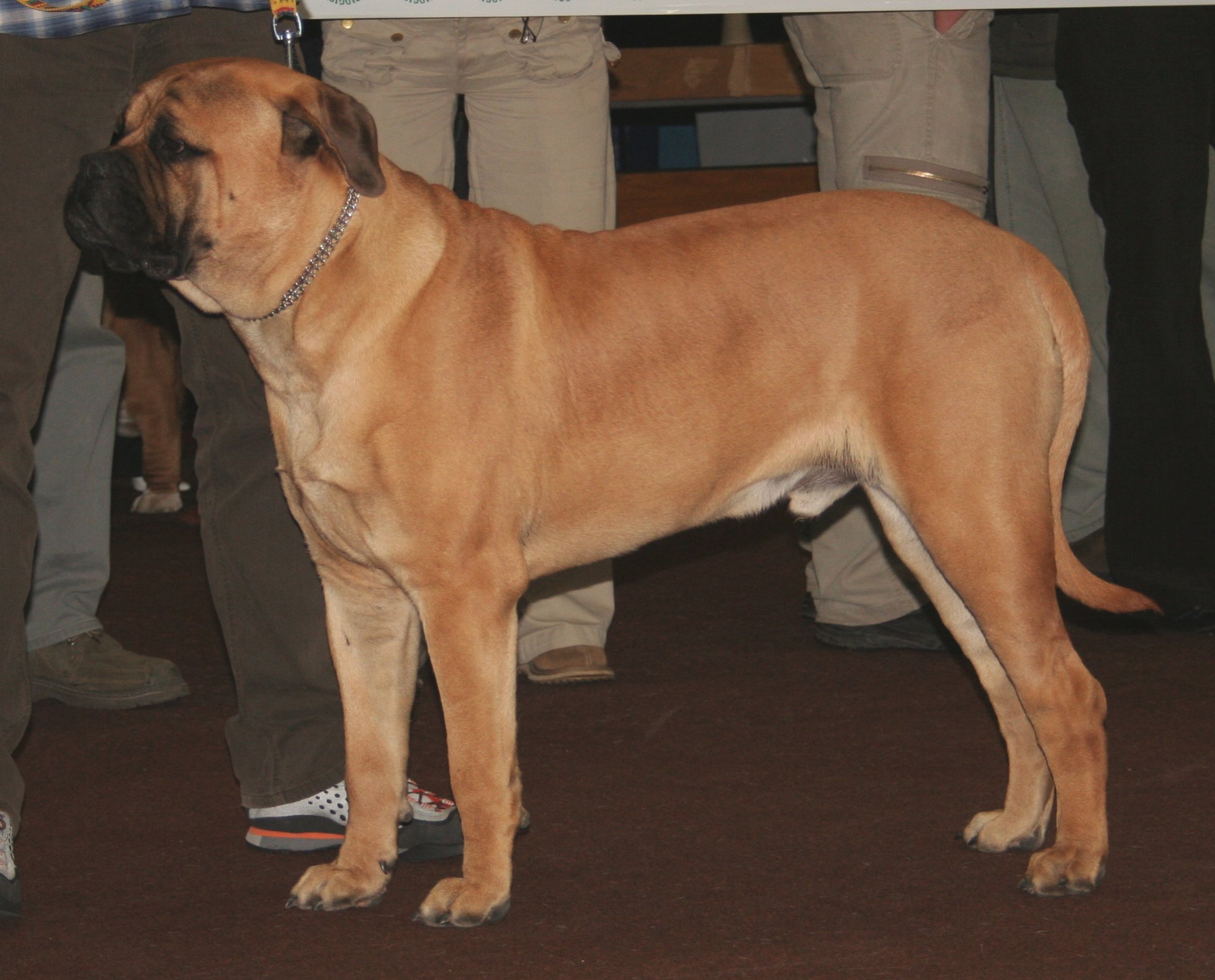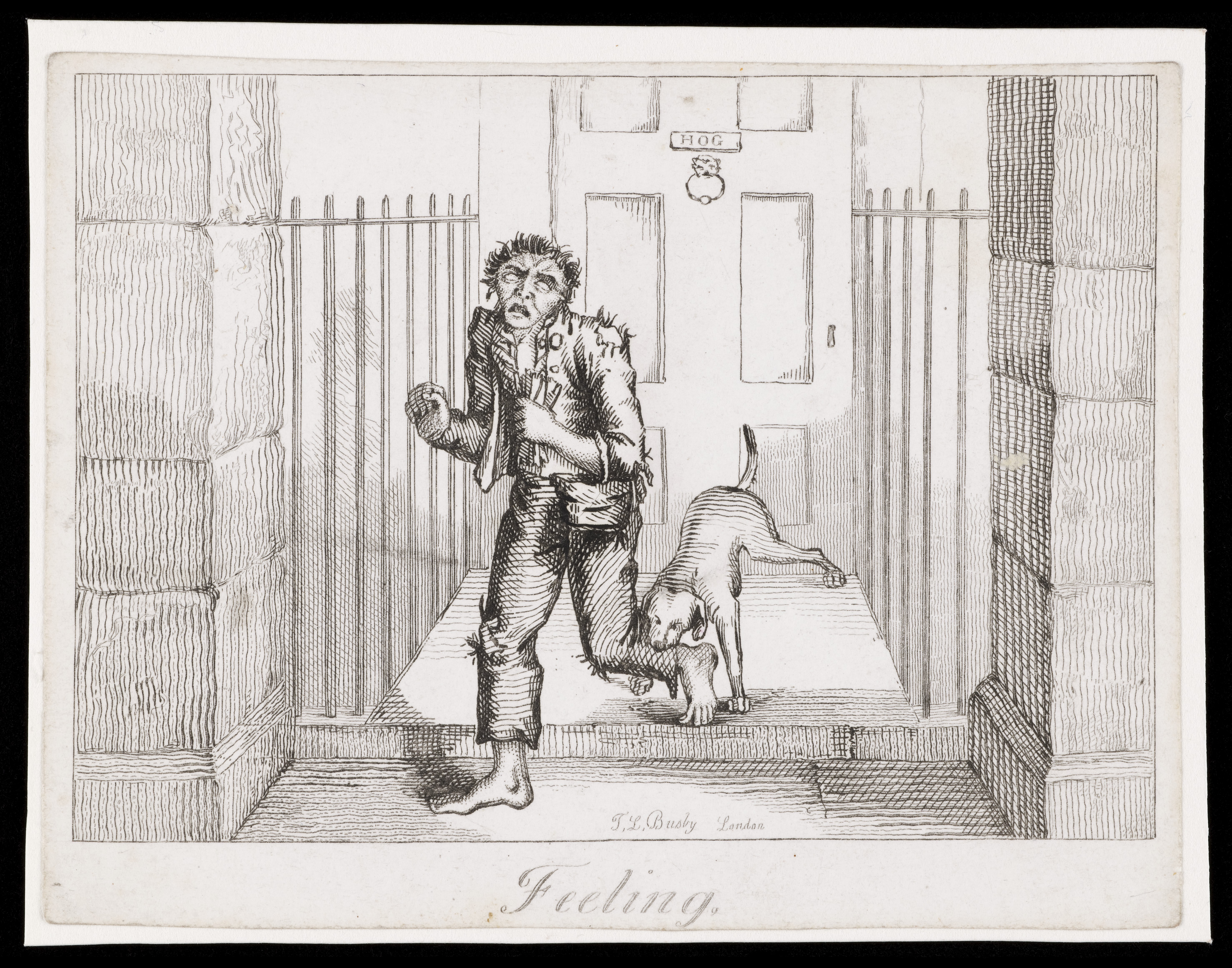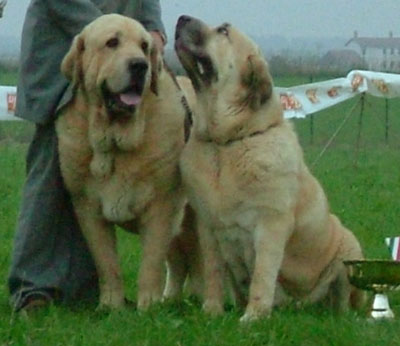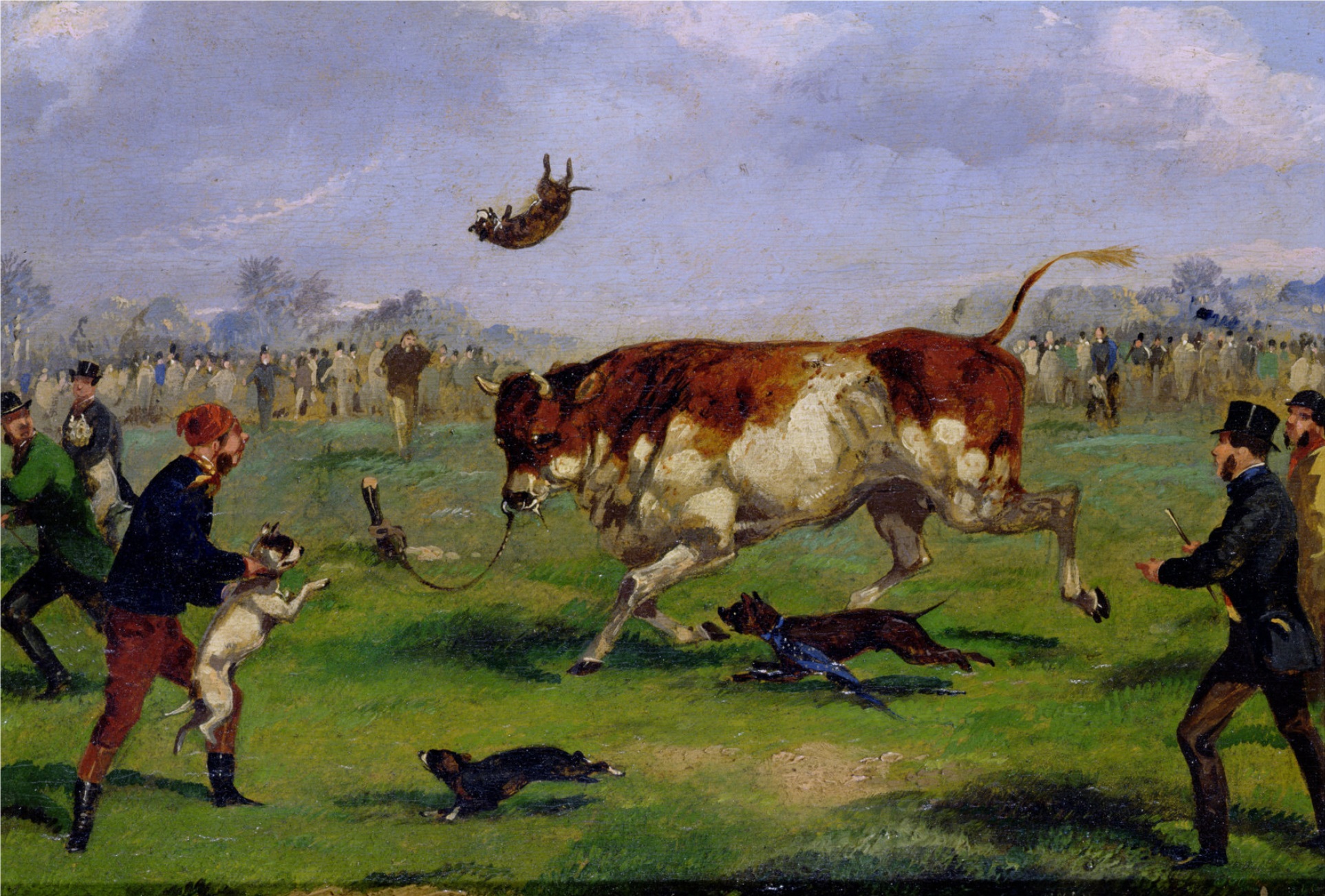|
Mastiffs
A mastiff is a large and powerful type of dog. Mastiffs are among the largest dogs, and typically have a short coat, a long low-set tail and large feet; the skull is large and bulky, the muzzle broad and short (brachycephalic) and the ears drooping and pendant-shaped. European and Asian records dating back 3,000 years show dogs of the mastiff type. Mastiffs have historically been guard dogs, protecting homes and property, although throughout history they have been used as hunting dogs, war dogs and for blood sports, such as fighting each other and other animals, including bulls, bears and even lions. Historical and archaeological evidence suggests that mastiffs have long been distinct in both form and function from the similarly large livestock guardian dogs from which they were most likely developed; they also form separate genetic populations. The Fédération Cynologique Internationale and some kennel clubs group the two types together as molossoid dogs; some modern lives ... [...More Info...] [...Related Items...] OR: [Wikipedia] [Google] [Baidu] |
Molossus (dog)
The Molossus ( el, Μολοσσός, Molossós; also known as the Molossian hound, Epirus mastiff) was a breed of dog from Ancient Greece. History The Molossus were dogs that were kept by the ancient Greek tribe and kingdom of the Molossians, who inhabited the region of Epirus. The Molossus were famous throughout the ancient world for their size and ferocity and were frequently mentioned in ancient literature, including the writings of Aristophanes, Aristotle, Grattius, Horace, Lucan, Lucretius, Martial, Nemesianus, Oppian of Apamea, Plautus, Seneca, Statius, Ovid, and Virgil. The Molossians issued silver coinage with an image of a Molossus as their emblem. It is sometimes stated in books and magazines, particularly in Continental Europe and North America, that all mastiff-type dogs are descended from the Molossus. This theory states that the breed's progenitors arrived in Molossia from Asia and were eventually discovered by the Romans who employed large numbers ... [...More Info...] [...Related Items...] OR: [Wikipedia] [Google] [Baidu] |
Bullmastiff
The Bullmastiff is a British breed of dog of mastiff type and large size, with a solid build and a short muzzle. It was developed as a guard dog in the nineteenth century by cross-breeding the English Mastiff with the now-extinct Old English Bulldog. It was recognised as a breed by The Kennel Club in 1924. History The origins of the Bullmastiff are unclear. In the eighteenth century, in some regions of England, the Old English Mastiff and English Bulldog were commonly inter-bred to produce dogs suitable for work guarding people and their property. By the beginning of the twentieth century this cross-breed was in widespread use as an aid to gamekeepers in the control of poaching. They were bred by gamekeepers for strength, size and speed using a cross of the tough, heavy and aggressive Bulldog of the nineteenth century with the large, strong, less aggressive Mastiff.Walkey B. The Bullmastiff Fancier's Manual. Sechelt B.C., Canada: Coast Arts Publishing; 1992 As a result, th ... [...More Info...] [...Related Items...] OR: [Wikipedia] [Google] [Baidu] |
Tibetan Mastiff
The Tibetan Mastiff ( bo, འདོགས་ཁྱི, THL: , Wylie: ) * Nepali: * Mongolian: * Hindi/ Garhwali/ Kumaoni: * Kashmiri: * Ladakhi: * Dzongkha: is a large size Tibetan dog breed. Its double coat is medium to long, subject to climate, and found in a wide variety of colors, including solid black, black and tan, various shades of red (from pale gold to deep red) and bluish-gray (dilute black), and sometimes with white markings around neck, chest and legs. Name The term ''mastiff'' was assigned by the Europeans who first came to Tibet because that name was used to refer to nearly all large dog breeds in the West. Early Western visitors to Tibet misnamed several of its breeds, such as the Tibetan terrier, which is not a terrier, and the Tibetan spaniel, which is not a spaniel. A better name for the breed might be the ''Tibetan mountain dog'' or—to encompass the landrace breed throughout its range—the ''Himalayan mountain dog''. Description Appearance ... [...More Info...] [...Related Items...] OR: [Wikipedia] [Google] [Baidu] |
Livestock Guardian Dog
A livestock guardian dog (LGD) is a dog type bred for the purpose of protecting livestock from Predation, predators. Livestock guardian dogs stay with the group of animals they protect as a full-time member of the flock or herd. Their ability to guard their herd is mainly instinctive, as the dog is bonded to the herd from an early age. Unlike herding dogs which control the movement of livestock, LGDs blend in with them, watching for intruders within the flock. The mere presence of a guardian dog is usually enough to ward off some predators, and LGDs confront predators by vocal intimidation, barking, and displaying very Dog aggression, aggressive behavior. The dog may attack or fight with a predator if it cannot drive it away. History Herding dogs originated in Western Asia, on the territory of modern Iran and Iraq in association with the beginning of livestock breeding. Domestication of sheep and goats began there in the 8-7th millennium BC. Back then shepherding was a diffic ... [...More Info...] [...Related Items...] OR: [Wikipedia] [Google] [Baidu] |
Dog Type
Dog types are broad categories of domestic dogs based on form, function, or style of work, lineage, or appearance. Some may be locally adapted dog types (or '' landraces'') that may have the visual characteristics of a modern purebred dog. In contrast, modern '' dog breeds'' strictly adhere to long-established breed standards, that began with documented foundation breeding stock sharing a common set of inheritable characteristics, developed by long-established, reputable kennel clubs that recognize the dog as a purebred. A "dog type" can be referred to broadly, as in gun dog, or more specifically, as in spaniel. Dogs raised and trained for a specific working ability rather than appearance may not closely resemble other dogs doing the same work, or any of the dogs of the analogous breed group of purebred dogs. Names in English The earliest books in the English language to mention numbers of dog types are from the "Cynegetica" (hunting literature), namely, ''The Art of Vene ... [...More Info...] [...Related Items...] OR: [Wikipedia] [Google] [Baidu] |
Guard Dog
A guard dog or watchdog (not to be confused with an attack dog) is a dog used to watch for and guard property against unwanted or unexpected human or animal intruders. The dog is discerning so that it does not annoy or attack the resident humans of the house. History The use of dogs as guardians is well known since ancient times. The Romans used to put mosaics (''Cave canem'' mosaics) at the entrance of the houses to warn visitors and intruders of the presence of dangerous dogs at the property. One of the first dog types used as guardians were the ancestral Mastiff-type landraces of the group known as Livestock guardian dogs which protected livestock against large predators such as wolves, bears and leopards. Orthrus is a famous example of a livestock guardian dog from the Greek mythology known for guarding Geryon's red cattle. Some ancient guard dogs in more urban areas, such as the extinct bandogges, were chained during the day and released at night to protect prope ... [...More Info...] [...Related Items...] OR: [Wikipedia] [Google] [Baidu] |
Alapaha Blue-Blood Bulldog
Alapaha may refer to: *Alapaha, Georgia *Alapaha River The Alapaha River is a U.S. Geological Survey. National Hydrography Dataset high-resolution flowline dataThe National Map, accessed April 18, 2011 river in southern Georgia and northern Florida in the United States. It is a tributary of t ... *Alapaha Rise, a 1st magnitude spring in Hamilton County, Florida * Lakeland, Georgia was named Alapaha from 1838 to 1857. {{Disambig ... [...More Info...] [...Related Items...] OR: [Wikipedia] [Google] [Baidu] |
United States
The United States of America (U.S.A. or USA), commonly known as the United States (U.S. or US) or America, is a country primarily located in North America. It consists of 50 U.S. state, states, a Washington, D.C., federal district, five major unincorporated territories, nine United States Minor Outlying Islands, Minor Outlying Islands, and 326 Indian reservations. The United States is also in Compact of Free Association, free association with three Oceania, Pacific Island Sovereign state, sovereign states: the Federated States of Micronesia, the Marshall Islands, and the Palau, Republic of Palau. It is the world's List of countries and dependencies by area, third-largest country by both land and total area. It shares land borders Canada–United States border, with Canada to its north and Mexico–United States border, with Mexico to its south and has maritime borders with the Bahamas, Cuba, Russia, and other nations. With a population of over 333 million, it is the List of ... [...More Info...] [...Related Items...] OR: [Wikipedia] [Google] [Baidu] |
Alapaha Blue Blood Bulldog
The Alapaha Blue Blood Bulldog is a breed of bulldog from the United States, and it is predominantly used as a guard dog. It is a very powerful, muscular breed with large head and brachycephalic muzzle. The hair coat is short, typically colored white with black, blue, buff or brown patches, and its tail is kept un- docked. Sexual dimorphism is common in the breed, with larger dogs typically twice the weight of smaller bitches. History The Alapaha Blue Blood Bulldog is a rare breed that is believed to be descended from Old English Bulldogs that were brought to the Americas in the 18th century where they were used in the blood sports of bull baiting and bear baiting; they were later used as cattle and pig herders. For multiple generations, the breed was bred solely by the Lane family of Rebecca, Georgia. They eventually started a breed registry with a dog called Otto, the foundation dog of the family's breeding operation. The dog's name has occasionally been used as a nickname fo ... [...More Info...] [...Related Items...] OR: [Wikipedia] [Google] [Baidu] |
Spanish Mastiff
The Spanish Mastiff or Mastín Español is a breed of dog from Spain, originally bred to be a guard dog and whose specialized purpose is to be a livestock guardian dog protecting flocks and/or herds from wolves and other predators. Historical context In medieval times, this dog has accompanied the herds of sheep crossing from northern to southern Spain, defending cattle from attack by wolves and other predators. The mastiff had the protection of chunky metal necklaces with skewers. Its function was primarily protective, unlike its fellow Carea dogs, whose function is grazing, driving the herds in response to indications of the shepherd. In some places it is known as ''perro merinero'' when it accompanies sheep of the Merino breed. The first breed standard of the Spanish Mastiff was made by the FCI in 1946. In 1981 the Asociación Española del Perro Mastín Español was formed, who organized a breeding program looking for the kind of large and strong mastiff of the past tim ... [...More Info...] [...Related Items...] OR: [Wikipedia] [Google] [Baidu] |
Big-game Hunting
Big-game hunting is the hunting of large game animals for meat, commercially valuable by-products (such as horns/ antlers, furs, tusks, bones, body fat/ oil, or special organs and contents), trophy/ taxidermy, or simply just for recreation ("sporting"). The term is often associated with the hunting of Africa's "Big Five" games (lion, African elephant, Cape buffalo, African leopard, and rhinoceros), and with tigers and rhinoceroses on the Indian subcontinent. History Hunting of big game for food is an ancient practice, possibly arising with the emergence of ''Homo sapiens'' ( anatomically modern humans), and possibly pre-dating it, given the known propensity of other great apes to hunt, and even eat their own species. The Schöningen spears and their correlation of finds are evidence that complex technological skills already existed 300,000 years ago, and are the first obvious proof of an active (big game) hunt. ''H. heidelbergensis'' already had intellectual a ... [...More Info...] [...Related Items...] OR: [Wikipedia] [Google] [Baidu] |
Bull-baiting
Bull-baiting is a blood sport involving pitting a bull against dogs. History England Crowds in London during the Royal Entry of James VI and I in March 1604 were entertained by bull-baiting. During the time of Queen Anne, bull-baiting was practised in London at Hockley-in-the-Hole, twice a week – and was also reasonably common in provincial towns, for instance at Birmingham's Bull Ring. At Tutbury, a bull was tied to an iron stake so that it could move within a radius of about 30 feet. The object of the sport was for the dogs to immobilize the bull. Before the event started, the bull's nose was blown full of pepper to enrage it before the baiting. The bull was often placed in a hole in the ground. A variant of bull-baiting was "pinning the bull", where specially-trained dogs would set upon the bull one at a time, a successful attack resulting in the dog fastening his teeth strongly in the bull's snout. The extinct Old English Bulldog was specially bred for this ... [...More Info...] [...Related Items...] OR: [Wikipedia] [Google] [Baidu] |








